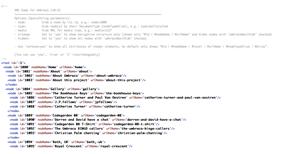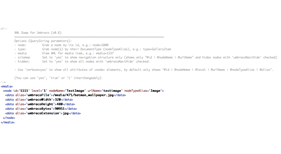XML Dump
If you’ve been developing XSLT for Umbraco, you’ve probably already done your share of <textarea><xsl:copy-of select="." /></textarea> to examine the XML you’re transforming... let’s get rid of that habit and do something much better.
With this simple package you’ll have instant access to all published nodes, selectable by id or document type - many browsers support viewing XML in a nice color-coded fashion, so now you can let IE6 do the only thing it’s good at and leave it open on your secondary screen :-)
Files Installed
The package installs a Template, an XSLT Macro and a Config - the files are:
~/masterpages/XMLDump.master
~/xslt/XMLDump.xslt
~/config/XMLDump.config
How To Use
A Note On Security
Because installing XMLDump will allow anyone to see the entire data structure of your site, I've decided to require an extra step that makes you, the developer, responsible for switching the feature on and off. You can do that in two different ways:
-
XMLDump will look for a property called
xmldumpAllowedIPsrecursively upwards from the start node selected for viewing (see below) and if that property contains the IP address of the current request (the REMOTE_ADDR server variable), it will render the XML. So you need to add a textstring property to your "website" Document Type and subsequently fill in your IP address on the corresponding content node before XMLDump will render anything. -
As of version 0.9.3 you can also add the IP address(es) to the
XMLDump.configfile in theconfigfolder - there should be an empty<xmldumpAllowedIPs>element in there which you can fill in.
Viewing the XML
After you've successfully installed the package, you can use the altTemplate syntax to view the underlying XML of your Umbraco website - just open your site in a web browser and go to the following URL:
http://yourwebsite.com/xmldump
Or, if you're not using Directory URLs:
http://yourwebsite.com/xmldump.aspx
You can also view the XML for a specific page by doing the same thing, e.g.:
http://yourwebsite.com/about/xmldump
XMLDump allows a set of options on the query string and conveniently displays what they are at the top of its output.
Revision History
- v0.9.6: Add
dictoption for Dictionary items. - v0.9.5: Add support for nuPickers XML and JSON properties. Add the
helpoption. - v0.9.4: Updated to use new build script
- v0.9.3: Add config file for the
xmldumpAllowedIPskey - v0.9.2: Support XPath CheckBox List and CheckBox Tree with the
mntpoption too. Add count of matched nodes to output forxpathoption - v0.9.1: Bugfix release
- v0.9: Lots of refactoring. Added options
search&mntp, changed some logic inxpathoption - v0.8: "Universal Binary" (compatible with both XML formats). Changed to use altTemplate syntax (e.g., to just get $currentPage). Added activation for security reasons
- v0.7: Added options:
xpath&property - v0.6: Added options:
media&sitemap - v0.5: Initial version, supporting the options:
node,type&hidden
Chriztian Steinmeier, April 2014 (Initial version: November 2009)
- Package Files
- Documentation
- Archived Files
Package files
Archived files
-
XMLDump-0.6.zipuploaded 11/12/2009 by Chriztian Steinmeier
For Umbraco: Version 7.2.x, Version 7.1.x, Version 7.0.x & .NET Version: -
XMLDump-0.7.zipuploaded 14/01/2010 by Chriztian Steinmeier
For Umbraco: Version 7.2.x, Version 7.1.x, Version 7.0.x & .NET Version: -
xmldump-41b2.xslt.zipuploaded 28/02/2010 by Chriztian Steinmeier
For Umbraco: Version 7.2.x, Version 7.1.x, Version 7.0.x & .NET Version: -
XMLDump.zipuploaded 15/03/2011 by Chriztian Steinmeier
For Umbraco: Version 7.2.x, Version 7.1.x, Version 7.0.x & .NET Version: 4.0 -
XMLDump-0.9.1.zipuploaded 23/11/2011 by Chriztian Steinmeier
For Umbraco: Version 7.2.x, Version 7.1.x, Version 7.0.x & .NET Version: 4.0 -
XMLDump-0.9.2.zipuploaded 23/05/2012 by Chriztian Steinmeier
For Umbraco: Version 7.2.x, Version 7.1.x, Version 7.0.x & .NET Version: 4.0 -
XMLDump-0.9.4.zipuploaded 11/04/2014 by Chriztian Steinmeier
For Umbraco: Version 7.2.x, Version 7.1.x, Version 7.0.x & .NET Version: 4.0

